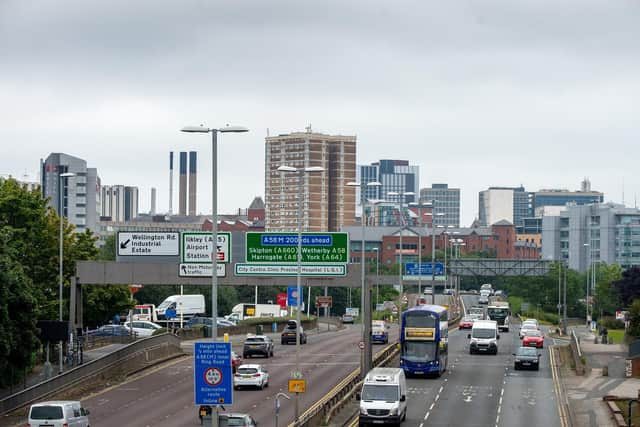Transport series: Why is Leeds so reliant on cars – and how else can roads be used?
The 1950s and 1960s was a time of immense social and economic change in Britain.
As the country recovered economically from the second world war, cities such as Leeds saw mass clearances of high-density – and sometimes squalid – inner-city housing, known as slums.
Advertisement
Hide AdAdvertisement
Hide AdThese were largely replaced with new, modern housing estates further away from the city centre, in places such as Whinmoor, Seacroft and Bramley.


Leeds’ emerging suburban communities no longer lived near where they worked, meaning they had to commute. This led to a boom in personal car ownership during the 1960s.
As a consequence of this, new roads with the space for large numbers of motorists needed to be built. This led to the UK’s first inter-city motorway being completed in 1968 – the M1 – which linked London to Leeds. Work had already started on the M62 – an east-west road linking Leeds with Manchester, Liverpool and Hull – and the city’s leaders sensed an opportunity.
An inner ring road was built in 1969, which would ensure cars would be able to circumvent the congested city centre, leading Leeds to market itself as the “motorway city of the 1970s”.
Advertisement
Hide AdAdvertisement
Hide AdIt’s since become a widely-maligned decision, as many feel it has led to increases in air pollution, traffic congestion and the city’s near-umbilical link to the personal car.
But one expert believes the positives the schemes brought to the city are too often overlooked.
Dr Anthony Whiteing, a transport expert at the University of Leeds, believes the early removal of traffic from the city centre has helped to make Leeds the commercial hub it is today.
“At the time, motorways were the future,” he said. “People thought they were great, and Leeds really promoted itself really well on this basis.
Advertisement
Hide AdAdvertisement
Hide Ad“For the first time, the city became a big transport crossroads – the railways never did that for Leeds. By building the M1 up from London and the M62, Leeds found itself at an important crossroads, and they successfully marketed around that.
“Clearly the motorways did carnage in parts of Leeds – where they ploughed the inner ring road through tunnels, while shops in the north of the city centre got demolished.”
The inner ring road is formed by several roads which orbit inner-city Leeds – taking in parts of the A58; the A64(M); the A61 and the M621.
Dr Whiteing said: “But there were positives – Leeds, even back then, was also noted as a leader in pedestrianisation in the city centre.”
Advertisement
Hide AdAdvertisement
Hide Ad“The inner ring road from Armley gyratory round the north of the city, although it has its issues, clears out traffic from the city centre and allows you to improve the city centre environment.
“Linking the historic arcades around the pedestrianisation around that retail core was a benefit. So it’s not all negative.”
But in spite of the motorway’s popularity in the 1970s, ensuing decades have led both to worsening road congestion and an increased scientific understanding of how air pollution leads to climate change.
Mark Parry is chair of Action for Yorkshire Transport – a pressure group which advocates green solutions to urban transport problems.
Advertisement
Hide AdAdvertisement
Hide AdHe said: “Historically the road network built up and we depended more on it. This led to the ‘motorway city of the 70s’, which didn’t help.
“This was the era when government policy was in favour of roads and attempting to wind down the railways. There was a general drift towards motor traffic.
“But the culture has changed since then – yes, car ownership has gone up, but on the other hand a lot of people are stuck in congestion. Nobody is getting from A to B very efficiently.
“In more recent years, we have become aware of different types of air pollution, which is killing a lot of people. Also, when you walk around a heavily trafficked area, there isn’t a lot of freedom to move around.”
Advertisement
Hide AdAdvertisement
Hide AdWest Yorkshire local authorities are now keen to promote “active travel”, which has led to the multi-million pound cycle superhighway between Bradford and Leeds, as well as plans to pedestrianise further parts of Leeds City Centre.
Mr Parry said: “(Transport Secretary) Grant Shapps recently looked at the problems with climate change and decided to promote cycling.
“The council now wants people to do more walking in the city centre and to places quite nearby to Elland Road, for example.
“Cycling is better for longer journeys than walking. It always seems ridiculous that you use one and a half tonnes of car to carry less than 100kg of person, whereas cycling is much more efficient.
Advertisement
Hide AdAdvertisement
Hide Ad“There is going to have to be a major cultural change – the likes of which have happened in the Netherlands and Denmark – it’s not impossible. There needs to be a major change and, whether people like it or not, we are going to change in the next few decades.”